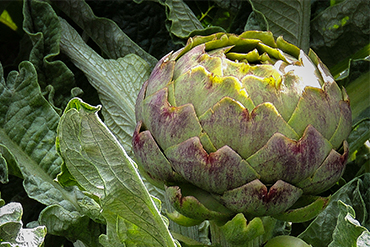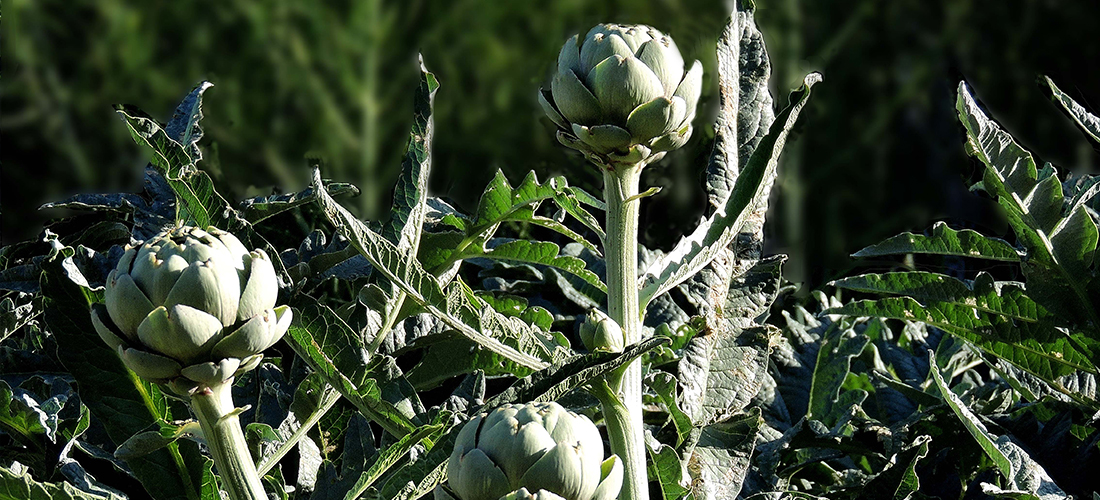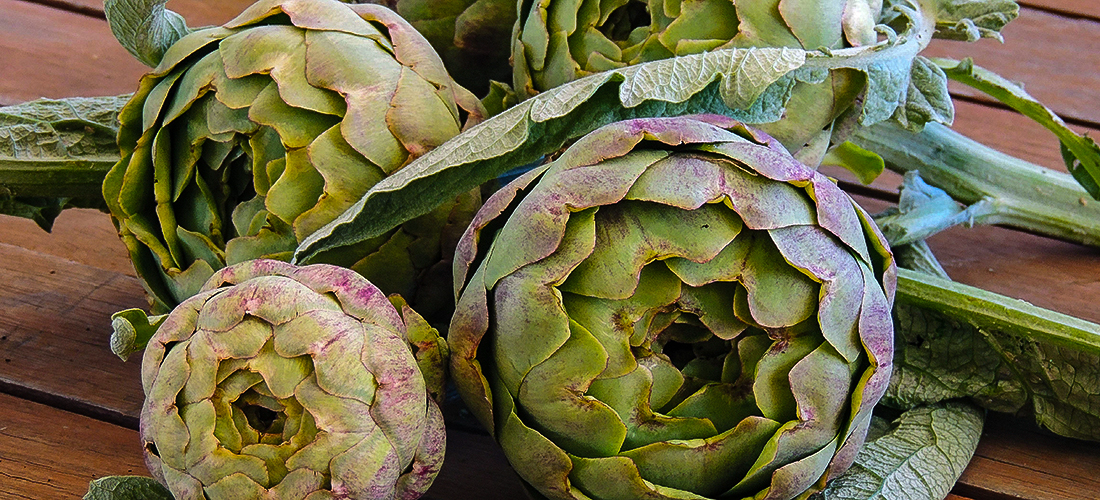
Globe Artichoke: The Edible Thistle
- Roots
The globe artichoke, an edible thistle, the aristocrat of the Renaissance kitchen garden was seen as the vegetable expression of civilised living. With its dramatic silver gray architectural leaves and elegant flower buds comprised of a tight head of pea-green and purple-tinged leaves, it was a botanical curiosity. It wasn’t the roots or leaves that were edible; it was the young flower buds and the succulent heart of the unopened flower that was protected by a fibrous ring - the choke.
Was it necessity? Was it curiosity?Or was it foolishness that inspired the first bite to identify which part of the plant was edible. Perhaps even more remarkably, what strange circumstance befell upon that adventurous person to then discover the jewel of the flower bud - the heart. Early culinary adventurers soon learnt that if the flower bud was left to bloom, the magnificent thistle-like flower was completely inedible.
Although the artichoke inspired admiration, they offered no instant gratification and still don't. Dining on artichokes was a slow culinary deconstruction to be savoured from the banqueting tables during the 15th and 16th centuries. With gently poached artichokes placed before the diner, they had to work hard for each morsel of delicate flesh located at the base of each leaf. A single leaf was dipped in melted butter seasoned with pepper and vinegar and then the flesh stripped from it by pulling the leaf across clenched teeth.
.jpg) The artichoke (Cynara cardunculus var. scolymus) was domesticated in Roman times, possibly in Sicily and spread by the Arabs during the early middle Ages. It was known in Italy by 1450, introduced in England during the reign of Henry VIII (1509-47) and introduced to the French Royal court by Catherine de Medicis in the 16th century. Betrothed to the second son of Francis I, King of France to form a dynastic allegiance, as her horses, carriages, cooks and maids rode from Florence to the court of Valois, they were reputed to be carrying with them parsley, artichokes, salads, forks, and glazed earthenware, which had never been used previously in the French palace kitchens.
The artichoke (Cynara cardunculus var. scolymus) was domesticated in Roman times, possibly in Sicily and spread by the Arabs during the early middle Ages. It was known in Italy by 1450, introduced in England during the reign of Henry VIII (1509-47) and introduced to the French Royal court by Catherine de Medicis in the 16th century. Betrothed to the second son of Francis I, King of France to form a dynastic allegiance, as her horses, carriages, cooks and maids rode from Florence to the court of Valois, they were reputed to be carrying with them parsley, artichokes, salads, forks, and glazed earthenware, which had never been used previously in the French palace kitchens.
Today, while the artichoke is still quintessentially a Mediterranean cuisine vegetable, in Australia, it is rarely purchased fresh and only seen on epicurean tables. Its days as an expression of civilised living have all but passed. It takes time to prepare and although this is not difficult, many are daunted by the technique and it needs to be prepared quickly to prevent discolouration of the flesh when it has been cut. The art of preparing an artichoke is slowly being lost as prepared hearts are now readily available, preserved in water, brine or oil in supermarkets and delicatessens.
But for me, artichokes are mandatory in the kitchen garden and stand proud next to my asparagus patch in the permanent garden bed. As an herbaceous perennial plant, they grow about a meter high and wide with the flowers emerging from the centre of the plant from spring through to early summer. The warm spring sun coaxes the nubile flowers out and within a week, they stand tall, elegant and inspire spring salads with fresh peas, asparagus and new potatoes.
 They have a large root system and need space to grow. If planted in well drained rich fertile soil with a generous layer of organic mulch and kept watered during hot spells, once established a single large plant can produces up to 30 buds. Once again, this spring, the artichokes provided me with plenty. Some were shared with friends, some lightly braised with peas and potatoes , others are preserved in oil for summer antipasto platters and homemade pizza.
They have a large root system and need space to grow. If planted in well drained rich fertile soil with a generous layer of organic mulch and kept watered during hot spells, once established a single large plant can produces up to 30 buds. Once again, this spring, the artichokes provided me with plenty. Some were shared with friends, some lightly braised with peas and potatoes , others are preserved in oil for summer antipasto platters and homemade pizza.
 The mysteries of the artichoke are still to be fully revealed. They alter the taste of water and wine. Water tastes sweeter after eating them while wine will lack its true taste. It’s rich in fibre, magnesium and potassium and a natural source of folate. It is a renewable resource that provides lignocellulosic biomass for energy, plant fibre for paper pulp and oil is extracted for biodiesel fuel production while its flower heads and leaves are used in pharmaceutical compounds. The humble artichoke is making a significant contribution to our health and well-being and living a more sustainable civilised life, even if it isn't appreciated as a epicurean vegetable.
The mysteries of the artichoke are still to be fully revealed. They alter the taste of water and wine. Water tastes sweeter after eating them while wine will lack its true taste. It’s rich in fibre, magnesium and potassium and a natural source of folate. It is a renewable resource that provides lignocellulosic biomass for energy, plant fibre for paper pulp and oil is extracted for biodiesel fuel production while its flower heads and leaves are used in pharmaceutical compounds. The humble artichoke is making a significant contribution to our health and well-being and living a more sustainable civilised life, even if it isn't appreciated as a epicurean vegetable.
Find a corner in your garden and plant out an artichoke in spring and soon its magnificent thistle-like flowers will inspire you to explore its culinary virtues.
